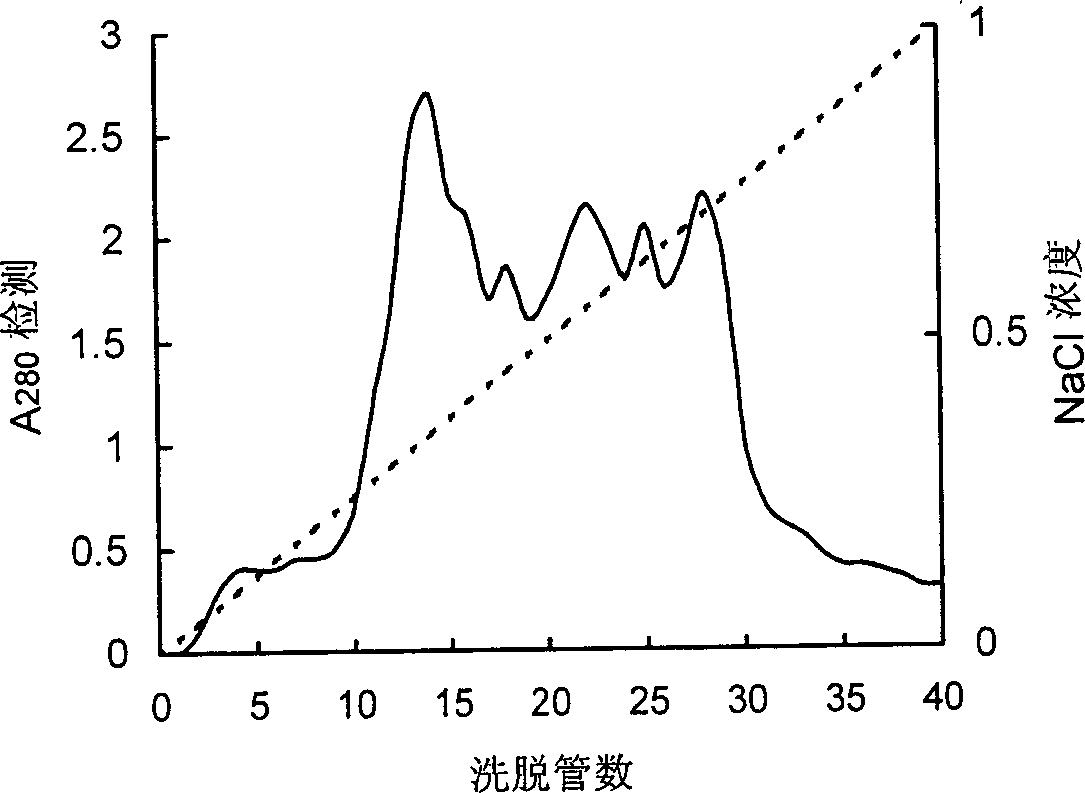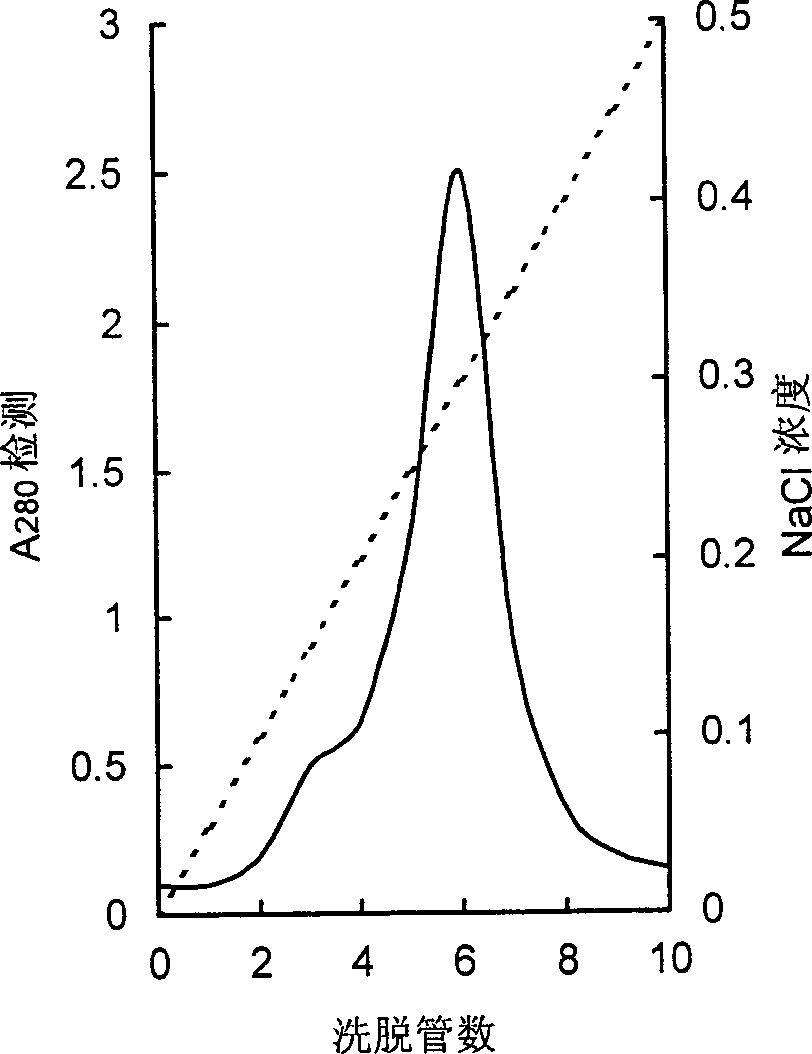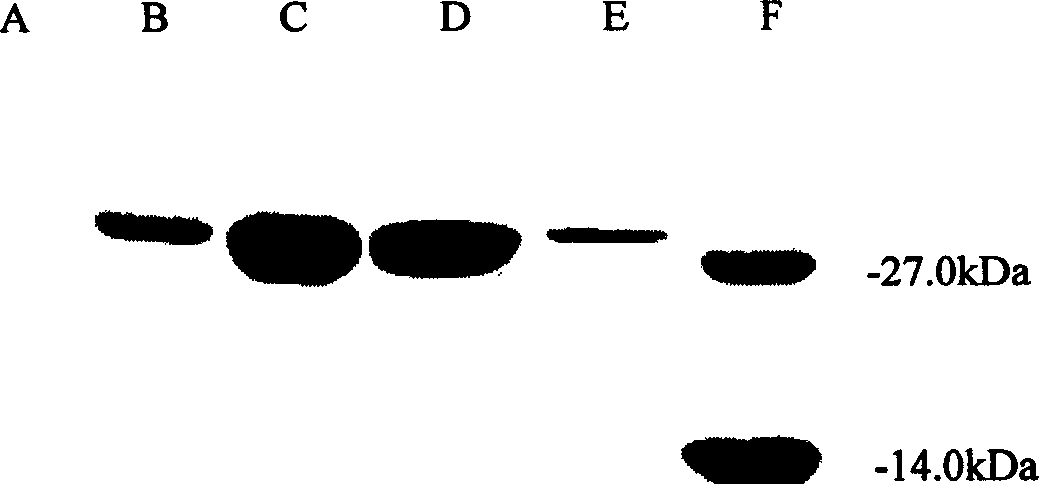Amaranth seed ribosome inactivating protein
A ribosome inactivation and amaranth seed technology is applied to the ribosome inactivation protein-amaranth seed protein and the fields of its preparation and application, and achieves the effects of vigorous growth and high yield
- Summary
- Abstract
- Description
- Claims
- Application Information
AI Technical Summary
Problems solved by technology
Method used
Image
Examples
Embodiment 1
[0016] Embodiment 1. Isolation and purification of amaranth seed protein (Amaramangin) from amaranth seed
[0017] Take 200g of amaranth seeds, add appropriate amount of 20mMol / L acetic acid buffer (pH4.5) to homogenate, centrifuge or filter to collect the extract, adjust the pH to 4.0 with 50% acetic acid, let stand to separate layers, centrifuge or filter to collect the supernatant , put the supernatant on the SP-agarose fast flow gel ion exchange column, wash the column with 20mMol / L pH4.5 acetate buffer, then wash away the impurity proteins with 20mMol / L pH6.0 phosphate buffer, and finally wash with 0~1M NaCl (in 20 mM pH 6.0 phosphate buffer) gradient elution. See Figure 1 for the elution profile.
[0018] Combine 9-15 tubes of collected liquid, adjust the pH to 4.0 with 50% acetic acid, add it to the SP-agarose fast-flow ion exchange column again, wash the column with 20mMol / L pH4.5 acetate buffer, and then wash the column with 10mMol / LpH7 .2 phosphate buffer to wash a...
Embodiment 2
[0019] Embodiment 2.SDS-polyacrylamide gel electrophoresis (SDS-PAGE)
[0020] Ribosome inactivating protein-maranth seed protein, carried out SDS-PAGE on the micro vertical plate electrophoresis instrument of Bio-Rad company, and SDS-PAGE is carried out by the method for Leammli, and separating gel concentration is 12%, and stacking gel concentration is 4%, After electrophoresis, according to Guo Yaojun's method (1991, Advances in Biochemistry and Biophysics, 18: 32-37), stain with Coomassie Brilliant Blue, and use trichosanthin (MW ~ 27kDa) and lysozyme (MW ~ 14kDa) as molecular weight standards to control, showing The molecular weight of amaranth seed protein is 29kDa. The SDS-PAGE results are shown in Figure 3.
Embodiment 3
[0021] Example 3. Alcian blue staining after SDS-PAGE
[0022] The amaranth seed protein was subjected to SDS-PAGE according to the method in Example 2, and the film after electrophoresis was stained with Alcian blue (Sun Chu, "Lectin", p21). The gel after SDS-PAGE was fixed in 12.5% trichloroacetic acid for 30 minutes, then oxidized in a periodic acid solution containing 7% acetic acid for one hour, and then placed in 0.5% sodium metabisulfite solution and fully shaken for 30 minutes. Finally stained with 0.5% Alcian blue (dissolved in 7% acetic acid) for 4 hours. The staining results showed that the amaranth protein band was blue-green, which proved that the amaranth protein was a glycoprotein.
[0023] The gel after glycoprotein staining was re-stained with Coomassie Brilliant Blue according to the method in Example 2, and it was observed that the position of the original staining band was the band of amaranth seed protein.
PUM
| Property | Measurement | Unit |
|---|---|---|
| Molecular weight | aaaaa | aaaaa |
Abstract
Description
Claims
Application Information
 Login to View More
Login to View More - R&D
- Intellectual Property
- Life Sciences
- Materials
- Tech Scout
- Unparalleled Data Quality
- Higher Quality Content
- 60% Fewer Hallucinations
Browse by: Latest US Patents, China's latest patents, Technical Efficacy Thesaurus, Application Domain, Technology Topic, Popular Technical Reports.
© 2025 PatSnap. All rights reserved.Legal|Privacy policy|Modern Slavery Act Transparency Statement|Sitemap|About US| Contact US: help@patsnap.com



